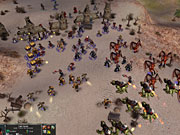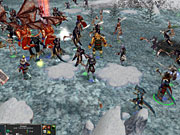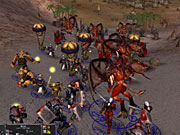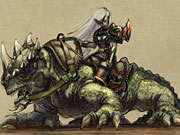Lords of EverQuest Hands-On Preview
We go hands-on with a very early version of this EverQuest-inspired real-time strategy game.
Lords of EverQuest will be one of Sony Online Entertainment's first non-massively multiplayer games. When the company announced two months ago that it was developing a real-time strategy game based on the wildly popular online role-playing game EverQuest, the news was met with some skepticism. Indeed, the inclusion of powerful commanders who can gain experience and enhance the performance of surrounding troops suggests a strong resemblance between Lords of EverQuest and another fantasy-themed real-time strategy game, Warcraft III. Other similarities, such as a character-driven, densely scripted, single-player campaign, are also part of the Lords of EverQuest package, though to its credit, Sony Online hasn't been defensive about the comparisons. And after playing an early version of the game, we found more than a handful of ways in which the game distinguishes itself.

The most obvious way in which Lords of EverQuest stands apart in the real-time strategy genre is its setting: the fantasy world of Norrath, introduced by the EverQuest role-playing game. The game's units are made up of many of the same races and classes that are familiar to EverQuest players, such as gnomish wizards and iksar necromancers. The special abilities and spells of these units are also largely borrowed from the original RPG, solidifying the connection between Lords of EverQuest and its spiritual predecessors. So just as you might do in the online RPG, you'll be able to use a dark elf cleric to cast a protective spell, or "buff," on some ogre warriors to enhance their fighting abilities. While a large percentage of the game's content is directly derived from previous titles, the designers of Lords of EverQuest have plans to introduce a few new aspects to the EverQuest universe, including five or six new races.
Three different factions will vie for power in Lords of EverQuest: the evil Shadowrealm, as well as a neutral and a good faction, which remain unannounced. The game includes 15 "lord" units (five for each faction), each of whom has his or her own special spells, abilities, and auras to enhance surrounding troops. During our play-testing session, we had the chance to choose from the Shadowrealm's stable of lords, which included Skass, an iksar necromancer; Lady T'lak, a dark elf rogue; Vekk, a troll shadow knight; Kreya, a gnomish wizard; and Urtt, an ogre warrior. Before you play through each of the three factions' 12-mission campaigns, you'll be required to choose which lord you will use.
Aside from the 15 lords associated with the specific factions, a handful of freelance lords will also be included in Lords of EverQuest. They will appear as nonplayer characters in the single-player campaign, but you'll be able to use them in multiplayer battles. One such lord is a goblin rogue named Darkeye. Though he shares the same class as the Shadowrealm's Lady T'lak, his special abilities differ slightly from the dark elf's. Whereas Lady T'lak gets abilities like blinding speed for faster attacks and assassinate (to instantly kill any non-lord, non-knight unit), Darkeye will enjoy advanced stealth capabilities, a better critical strike attack than Lady T'lak, and the ability to lay traps. These special abilities will become unlocked automatically as the lords gain experience from combat.

Similarly, the three factions will possess analogous units that are slightly different from one another. For instance, one faction's magicians may be able to summon air elementals, while another faction's magicians will only be able to summon earth elementals, which would obviously have different strengths and weaknesses from the wind elementals.
Each of the units in Lords of EverQuest will be able to carry items and gain experience levels. As units level up, they gain new skills, become more powerful, and go up in rank every four levels. Each change in rank reflects in the units' appearance, so experienced troops will be immediately recognizable on the battlefield. High-ranking spellcaster units may have their staves enhanced with a colored glow, while frontline combat units will be distinguished by new armor and large, ornate weaponry.
A Lord of EverQuest Bashes YOU!
Once units reach level six, they become eligible for knighthood. Knighting a unit gives it a 25 percent bonus in health and in ability to deal damage, plus an aura (smaller than the ones radiated by the lords) and a special bonus ability that is unlocked only with knighthood. So if you knight one of your troll shadow knights (known as "the wretched" in the game), he'll gain harm touch as his knight ability and an aura that improves the armor and raises the attack damage of nearby friendly units. Knights also have the ability to gain levels up to level 30, like lords, whereas regular units may advance only as high as level 20. The downside of knighthood is that knighted units gain experience more slowly than normal units, and you're limited to using two knights at a time.

During our demonstration, Sony Online producer James Parker showed us some of the interface screens that you'll use in between missions during the game's single-player campaign. Immediately after completing a mission, you'll be able to choose a limited number of your surviving units to transfer over to the next battle; the number of units you can carry over will depend on your lord's experience level as well as other factors, such as how many side quests you completed during the last mission. Once that business is completed, you'll see an overview map of the lands you've conquered. At times, the mission tree will branch, letting you choose which area of the land you want to conquer next. You'll never really be able to skip a mission completely, since you'll eventually have to conquer each territory on the map. However, the order in which you take on each mission does matter, because different territories will unlock different parts of your faction's technology tree as you make your way through the campaigns.
Finally, after getting briefed on the game's background, we were able to try out a multiplayer skirmish match with two GameSpot editors and two AI computer players on a four-player map. The first thing we noticed is that the game uses a right-click action interface standard to most strategy games, so experienced players will immediately feel at home. The user interface boxes, such as the minimap and unit information box, are all movable and can be selectively minimized in order to see more of the battlefield. Though the engine is quite capable of rendering dozens of units onscreen at the same time, you are only allowed to select a dozen units at once, so you'll need to use multiple control groups to manage large armies.
There's only one resource in Lords of EverQuest--platinum, which is harvested from mines that contain finite amounts of the stuff. Each faction will have a different method of mining--the Shadowrealm, which we played, uses clockwork spiders (manufactured by gnomes) to harvest ore. These units will make a beeline for the nearest mine if they're set to rally by it, and their bellies will swell as they gather more ore, until they finally harvest a full load to bring back to your base. The Shadowrealm's defensive structures proved to be more interesting. They're called bone piles; instead of simply shooting at invading enemies like a standard tower, skeletal arms reach up out of the ground and hold up to six foes in place so that your ranged units can safely take potshots at them. Troops immobilized by the bone piles will also take a small amount of damage. Aside from the fortress, which serves as the town center, and the bone piles, the rest of the Shadowrealm buildings seem fairly straightforward; each building lets you build one or two unit types and their corresponding upgrades, which you can research by spending additional platinum.

We tried out as many of the Shadowrealm units as possible. After expanding to a nearby mine, we created a mixed force of sacrificial healer units for healing capability, ogre warriors, tricksters (dark elf rogues), goblin blitzers (small goblins that throw fireballs while tethered to hot-air balloons), venom spitters (cavalry units mounted on giant lizards that shoot poison at a distance), and t'xol mogri (flying demons). We were able to catch both AI and human opponents off-guard with the help of the trickster units, which are equipped with a powerful plague trap ability. Tricksters are modeled after the traditional EverQuest rogue character--they have little health but are capable of dealing huge melee damage. The winged t'xol mogri units also appeared to be quite powerful.
Currently, Sony Online is planning to start the first phase of beta testing for Lords of EverQuest soon, in preparation for release toward the end of this year. The company expects to use the results of the beta test to adjust game balance issues between the three factions. Though two of the factions remain unannounced, just about all the unit and building content is in place or nearing completion for both of them. Lords of EverQuest is currently slated to ship in the fall of this year.
Got a news tip or want to contact us directly? Email news@gamespot.com
Join the conversation